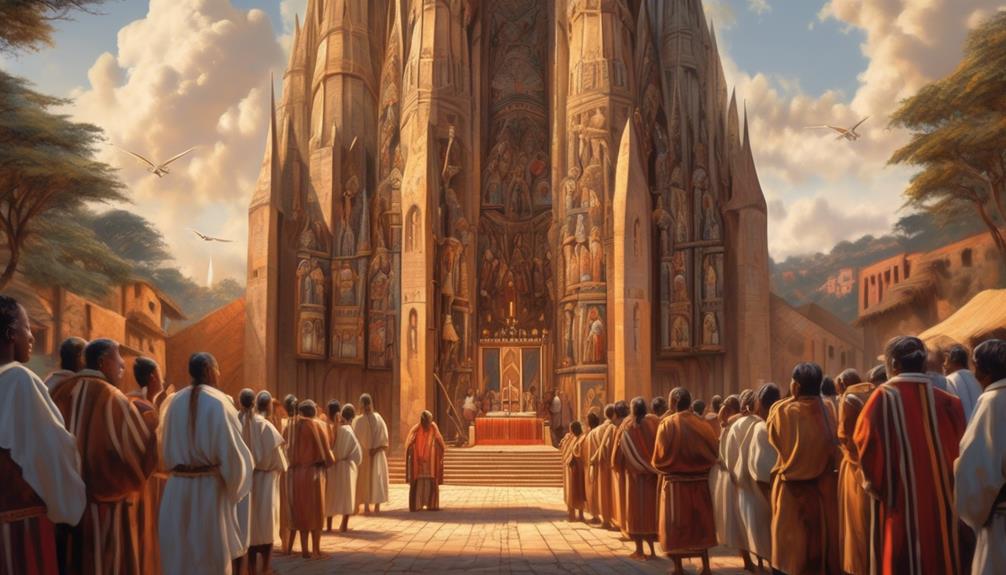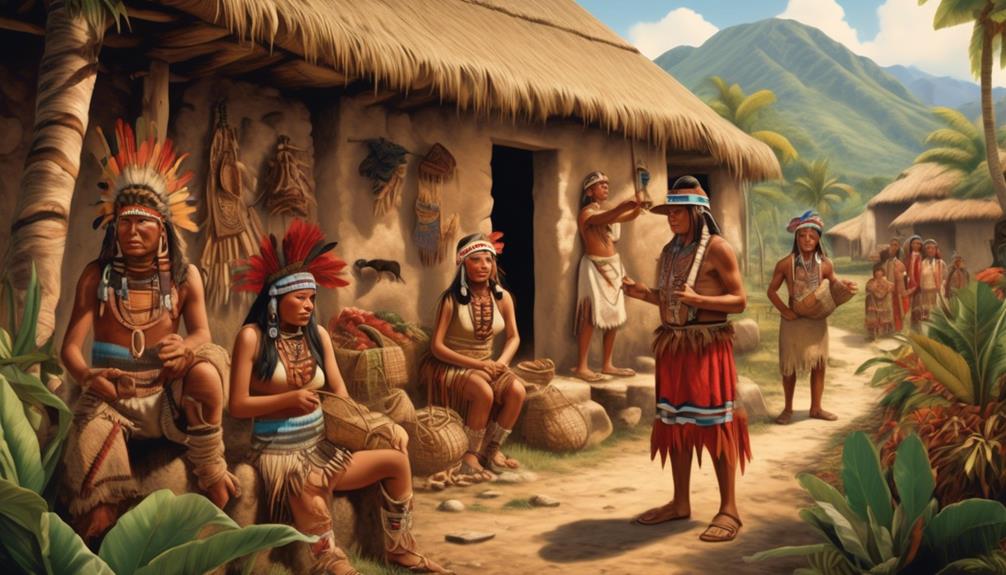The extensive influence of Catholicism on indigenous communities resulted in significant changes across various aspects of their culture and daily routines.
From spiritual transformation to social reorganization, the introduction of Catholicism ushered in a multitude of shifts that continue to reverberate through indigenous communities.
As we explore the multifaceted impact, it becomes evident that the integration of Catholicism brought forth both challenges and opportunities, shaping the indigenous way of life in ways that are both complex and compelling.
Key Takeaways
- The introduction of Catholicism led to a spiritual transformation and syncretism among indigenous people, as they integrated Catholic teachings while preserving their cultural and spiritual heritage.
- The social reorganization and power dynamics within indigenous communities shifted, as traditional leadership systems were challenged and replaced by the Catholic Church hierarchy.
- Indigenous communities experienced economic shifts and exploitation, as they integrated into broader trade networks and their traditional subsistence economies were replaced by labor-intensive agricultural practices that benefited the Catholic Church and European settlers.
- Catholicism had a significant cultural impact, as it influenced indigenous languages, ideologies, and artistic styles, and led to the emergence of unique syncretic expressions of faith through the blending of Catholic rituals, symbols, and stories with indigenous ceremonies and narratives.
Spiritual Transformation
The impact of Catholicism on indigenous people led to a profound spiritual transformation within their communities, altering their traditional belief systems and practices. The introduction of Catholicism often brought about a significant shift in personal beliefs, as indigenous individuals encountered new religious doctrines and teachings. This shift wasn't merely individual but also had a collective impact on community practices. As personal beliefs evolved, so did the communal rituals, ceremonies, and traditions that had been integral to indigenous societies for generations.
The arrival of Catholicism prompted introspection and reevaluation of personal spirituality among indigenous people. Individuals grappled with reconciling their traditional spiritual beliefs with the tenets of Catholicism, leading to a complex interweaving of old and new practices. This internal struggle also reverberated throughout the community, as leaders and members sought to integrate Catholic teachings into their existing belief systems while preserving the essence of their cultural and spiritual heritage.
The resultant fusion of Catholicism with indigenous spirituality gave rise to unique syncretic expressions of faith and community practices, marking a pivotal moment in the spiritual history of indigenous peoples.
Social Reorganization

Upon the introduction of Catholicism, indigenous communities underwent a profound reorganization of their social structures and relationships, as the new religious framework influenced the dynamics of leadership, community roles, and intergroup interactions. This reshaping of social organization had a significant impact on interpersonal relationships and community structure, leading to both intended and unintended consequences.
| Changes in Social Structure | Effects on Indigenous Communities |
|---|---|
| Shift from traditional leadership systems to Catholic Church hierarchy | Displacement of traditional leaders and alteration of power dynamics within communities |
| Redefinition of community roles based on Catholic teachings | Transformation of cultural practices and social norms, leading to potential conflicts and tensions |
| Integration of indigenous communities into wider Catholic networks | Exposure to external influences and potential erosion of traditional customs and values |
| Formation of new intergroup interactions guided by Catholic principles | Reconfiguration of social alliances and potential fragmentation of indigenous solidarity |
The introduction of Catholicism brought about a complex reorganization of indigenous social structures, reflecting the intricate interplay between religious doctrines and indigenous ways of life. This resulted in a multifaceted transformation of interpersonal relationships and community dynamics, which continues to shape indigenous societies to this day.
Economic Shifts
Following the introduction of Catholicism, the economic landscape of indigenous communities underwent significant shifts, reshaping traditional practices and trade dynamics. The arrival of Catholicism often resulted in the integration of indigenous communities into broader trade networks, exposing them to new goods and markets. However, this integration also led to the exploitation of indigenous labor for the benefit of the Catholic Church and European settlers.
The establishment of Catholic missions often disrupted existing indigenous economic systems. Traditional subsistence economies were replaced by labor-intensive agricultural practices, with indigenous people being coerced into working on mission-owned lands. This shift not only undermined traditional economic autonomy but also led to the concentration of wealth and resources in the hands of the Catholic Church and colonial authorities.
Furthermore, the introduction of Catholicism altered existing trade networks. Indigenous communities were often forced to trade on terms dictated by the Church or colonial powers, leading to the exploitation of their resources and labor. As a result, the economic impact of Catholicism on indigenous communities was characterized by the restructuring of traditional economic practices and the exploitation of indigenous labor for the benefit of external powers.
Power Dynamics

After the economic shifts brought about by the introduction of Catholicism, the power dynamics within indigenous communities underwent significant reconfiguration, altering the traditional structures of authority and influence. The arrival of Catholicism introduced a new religious hierarchy that challenged existing authority dynamics. This shift was particularly evident in the establishment of Catholic missions, which often operated as centers of power and influence, leading to a reorganization of traditional leadership roles within indigenous communities. Additionally, the influence dynamics within these communities were reshaped as conversion resistance sparked tensions between those embracing Catholicism and those adhering to indigenous spiritual beliefs. This resistance to conversion led to internal power struggles and social divisions, impacting the influence of traditional leaders and altering the dynamics of community decision-making.
| Authority Dynamics | Religious Hierarchy | Influence Dynamics | Conversion Resistance |
|---|---|---|---|
| Traditional leaders' roles challenged | Establishment of Catholic missions | Tensions between conversion and resistance | Impact on community decision-making |
These power dynamics reflect the complexities that emerged within indigenous communities following the introduction of Catholicism.
Cultural Syncretism
The process of cultural syncretism between Catholicism and indigenous traditions resulted in a complex interweaving of religious practices and beliefs, shaping the cultural landscape of indigenous communities. This religious blending and cultural adaptation fostered a dynamic environment where elements of Catholicism and indigenous traditions coalesced, leading to the emergence of unique religious practices and belief systems.
- Religious Blending: The amalgamation of Catholic rituals with indigenous ceremonies created hybrid religious practices, such as integrating Catholic saints with traditional deities.
- Cultural Adaptation: Indigenous communities adapted Catholic symbols and stories to align with their own cultural narratives, creating a distinctive blend of religious iconography and folklore.
- Syncretic Festivals: The development of syncretic festivals and celebrations, where Catholic feast days became intertwined with indigenous rituals and customs.
- Artistic Expression: The fusion of Catholic and indigenous artistic styles and techniques, resulting in a distinct visual representation of religious beliefs.
- Linguistic Influence: The adoption of Catholic vocabulary and concepts into indigenous languages, reflecting the integration of religious ideologies.
This cultural syncretism not only transformed the religious landscape but also influenced the social, artistic, and linguistic domains of indigenous life.
Frequently Asked Questions
How Did the Introduction of Catholicism Affect the Indigenous People's Access to Traditional Spiritual Practices and Beliefs?
The introduction of Catholicism had a significant impact on the indigenous people's access to traditional spiritual practices and beliefs. It led to a shift in power dynamics and cultural assimilation, influencing economic shifts and syncretism examples.
The imposition of Catholicism limited the indigenous people's ability to freely engage in traditional practices and beliefs, contributing to a loss of cultural autonomy. This led to a complex interplay between traditional spirituality and Catholicism, affecting indigenous communities profoundly.
What Were the Specific Social Changes Experienced by Indigenous Communities as a Result of the Introduction of Catholicism?
Social integration and cultural assimilation underwent significant changes in indigenous communities following the introduction of Catholicism. This shift impacted social structures, traditional practices, and belief systems.
The influence of Catholicism led to the adoption of new social norms and religious practices, altering the fabric of indigenous societies. The assimilation of Catholic beliefs and practices into daily life reshaped traditional indigenous culture and social dynamics, contributing to a complex interweaving of traditions.
Did the Introduction of Catholicism Lead to Any Economic Shifts Within Indigenous Communities, and if So, What Were They?
The introduction of Catholicism did lead to economic shifts within indigenous communities. As the focus shifted towards the Catholic Church, indigenous economic practices often adapted to align with the Church's teachings. This could involve changes in trade, labor, or resource allocation.
Additionally, cultural assimilation often brought about economic changes as indigenous communities adopted new practices and norms associated with Catholicism, influencing their economic activities.
How Did the Power Dynamics Within Indigenous Societies Change After the Introduction of Catholicism?
Power dynamics within indigenous societies shifted significantly after the introduction of Catholicism.
The arrival of Catholicism led to cultural assimilation, altering the traditional structures of authority and influence.
Indigenous leaders who resisted conversion often faced marginalization, as the Catholic Church gained prominence.
This change in power dynamics resulted in a shift in societal hierarchies and the erosion of indigenous autonomy.
The impact of Catholicism on indigenous power structures was profound and enduring.
Can You Provide Examples of Cultural Syncretism Resulting From the Interaction Between Catholicism and Indigenous Traditions?
Cultural hybridization resulting from the interaction between Catholicism and indigenous traditions is evident in various practices. One such practice is the incorporation of indigenous rituals into Catholic ceremonies. This blending of traditions is a testament to the adaptability and openness of both Catholicism and indigenous belief systems.
Another example of cultural hybridization is the adaptation of Catholic symbols to align with indigenous beliefs. For instance, statues of Catholic saints may be depicted with indigenous features or dressed in traditional indigenous clothing. This blending of visual elements serves to bridge the gap between the two belief systems and create a sense of familiarity and connection for indigenous communities.
This religious syncretism reflects the dynamic nature of cultural exchange, where both traditions influence and reshape each other. It is a testament to the resilience and creativity of indigenous communities in finding ways to maintain their cultural identity while incorporating elements of Catholicism.
These examples demonstrate the complex and multifaceted nature of the cultural impact of Catholicism on indigenous communities. It is not a simple case of assimilation or eradication of indigenous traditions, but rather a process of negotiation, adaptation, and mutual influence. The resulting hybridization is a testament to the richness and diversity of cultural expression.
Conclusion
In conclusion, the introduction of Catholicism had a profound impact on the lives of indigenous people. It led to spiritual transformation, social reorganization, economic shifts, power dynamics, and cultural syncretism.
Like a river carving its path through the land, the influence of Catholicism reshaped the lives and traditions of indigenous communities. It created a complex tapestry of change and adaptation.
The lasting effects of this introduction continue to shape the cultural landscape of indigenous societies to this day.
Mary is a passionate writer who brings creativity and a fresh perspective to our team. Her words have the power to captivate and inspire, making her an essential contributor to our content. Mary’s commitment to storytelling and dedication to promoting Indigenous culture ensures that her work touches the hearts of our readers. We’re fortunate to have her as part of our team.










